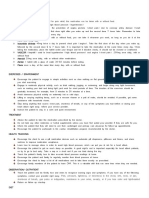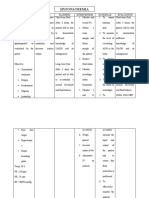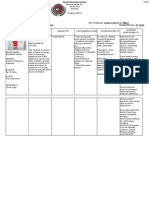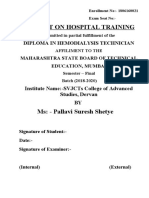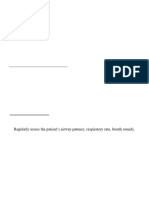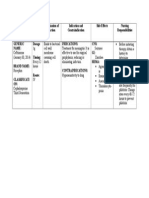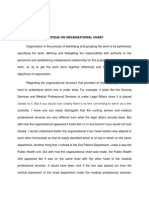0 ratings0% found this document useful (0 votes)
757 viewsPleural Effusion Fdar
Pleural Effusion Fdar
Uploaded by
vanessabdeveraThe patient had ineffective breathing due to pleural effusion, exhibiting Kussmaul breathing and a respiratory rate of 24. After repositioning the bed, deep breathing exercises, monitoring oxygen levels, and administering a bronchodilator, the patient's respiratory rate normalized to 19.
The patient was at risk of infection after chest thoracostomy tube insertion. To reduce this risk, the nurse assessed for signs of infection, emphasized hand washing, changed the dressing daily, kept the surgical area clean and dry, administered antibiotics, and maintained a clean environment. These interventions prevented infection.
Copyright:
© All Rights Reserved
Available Formats
Download as DOCX, PDF, TXT or read online from Scribd
Pleural Effusion Fdar
Pleural Effusion Fdar
Uploaded by
vanessabdevera0 ratings0% found this document useful (0 votes)
757 views1 pageThe patient had ineffective breathing due to pleural effusion, exhibiting Kussmaul breathing and a respiratory rate of 24. After repositioning the bed, deep breathing exercises, monitoring oxygen levels, and administering a bronchodilator, the patient's respiratory rate normalized to 19.
The patient was at risk of infection after chest thoracostomy tube insertion. To reduce this risk, the nurse assessed for signs of infection, emphasized hand washing, changed the dressing daily, kept the surgical area clean and dry, administered antibiotics, and maintained a clean environment. These interventions prevented infection.
Original Description:
Pleural Effusion Fdar
Copyright
© © All Rights Reserved
Available Formats
DOCX, PDF, TXT or read online from Scribd
Share this document
Did you find this document useful?
Is this content inappropriate?
The patient had ineffective breathing due to pleural effusion, exhibiting Kussmaul breathing and a respiratory rate of 24. After repositioning the bed, deep breathing exercises, monitoring oxygen levels, and administering a bronchodilator, the patient's respiratory rate normalized to 19.
The patient was at risk of infection after chest thoracostomy tube insertion. To reduce this risk, the nurse assessed for signs of infection, emphasized hand washing, changed the dressing daily, kept the surgical area clean and dry, administered antibiotics, and maintained a clean environment. These interventions prevented infection.
Copyright:
© All Rights Reserved
Available Formats
Download as DOCX, PDF, TXT or read online from Scribd
Download as docx, pdf, or txt
0 ratings0% found this document useful (0 votes)
757 views1 pagePleural Effusion Fdar
Pleural Effusion Fdar
Uploaded by
vanessabdeveraThe patient had ineffective breathing due to pleural effusion, exhibiting Kussmaul breathing and a respiratory rate of 24. After repositioning the bed, deep breathing exercises, monitoring oxygen levels, and administering a bronchodilator, the patient's respiratory rate normalized to 19.
The patient was at risk of infection after chest thoracostomy tube insertion. To reduce this risk, the nurse assessed for signs of infection, emphasized hand washing, changed the dressing daily, kept the surgical area clean and dry, administered antibiotics, and maintained a clean environment. These interventions prevented infection.
Copyright:
© All Rights Reserved
Available Formats
Download as DOCX, PDF, TXT or read online from Scribd
Download as docx, pdf, or txt
You are on page 1of 1
1.
F - Ineffective Breathing Pattern related to narrowed lung expansion
secondary to pleural effusion
D - Kussmaul breathing; Respiratory rate of 24 breaths per minute
A Respiratory rate was rechecked
Positioned bed on semi-fowlers
Encourage deep breathing exercises
Monitor O2 saturation using pulse oximetry
Administer bronchodilator as prescribed
R Respiratory rate normalized as evidenced by 19 breaths per minute
2. F Risk for infection related to surgical opening secondary to Chest
Thoracostomy Tube insertion
D Chest Thoracostomy Tube was inserted at Right side of patient
A Assess for any sign of infection, especially the body temperature
Emphasize the importance of hand washing technique
Change the dressing daily
Keep the area around the surgical opening clean and dry
Keep the environment clean
Administer antibiotics as prescribed
R Interventions were done to reduce the chance of the patient from having an
infection. Patient
showed no signs of infection.
You might also like
- Cva NCPDocument1 pageCva NCPxiang jinNo ratings yet
- Case Group Work #2 CHAPTER 6 Learning Exercise 6.4 L&M 03-03-2021 SituationDocument3 pagesCase Group Work #2 CHAPTER 6 Learning Exercise 6.4 L&M 03-03-2021 SituationZunnel CortesNo ratings yet
- Subjective Cues:: Nursing Care ProcessDocument8 pagesSubjective Cues:: Nursing Care ProcessBianca Marithè RejanoNo ratings yet
- Adam L. Penenberg: Neurofocus Uses Neuromarketing To Hack Your BrainDocument2 pagesAdam L. Penenberg: Neurofocus Uses Neuromarketing To Hack Your BrainvanessabdeveraNo ratings yet
- NCP RiskDocument2 pagesNCP RiskNura ZeinNo ratings yet
- NCP Gastric CancerDocument6 pagesNCP Gastric Cancerhayascent hilarioNo ratings yet
- NCPDocument14 pagesNCPRaidis Pangilinan0% (1)
- Surgical NCPDocument6 pagesSurgical NCPAreeya SushmitaNo ratings yet
- Assessment Explanation of The Problem Planning Nursing Intervention Rationale EvaluationDocument2 pagesAssessment Explanation of The Problem Planning Nursing Intervention Rationale EvaluationRodolfo Bong SemaneroNo ratings yet
- Discharge PlanningDocument2 pagesDischarge PlanningHannah BangkilingNo ratings yet
- HTP Ineffective BreathingDocument3 pagesHTP Ineffective BreathingShyrra Edades Pinder100% (1)
- HYPONATREMIADocument3 pagesHYPONATREMIADienizs Labini TadenaNo ratings yet
- NCPDocument3 pagesNCPErica Denice CastilloNo ratings yet
- Nursing Care Plan: Cues Nursing Diagnosis Analysis Goal and Objectives Interventions Rationale EvaluationDocument3 pagesNursing Care Plan: Cues Nursing Diagnosis Analysis Goal and Objectives Interventions Rationale EvaluationCalimlim KimNo ratings yet
- Discharge PlanningDocument3 pagesDischarge PlanningMaye ArugayNo ratings yet
- NCP Decreased Cardiac OutputDocument2 pagesNCP Decreased Cardiac OutputYamete KudasaiNo ratings yet
- NCP UreteroDocument1 pageNCP UreteroCerie Anne OlayNo ratings yet
- NCP 2 LRDR For PrintDocument2 pagesNCP 2 LRDR For PrintGeorge PandaNo ratings yet
- NCP Impaired Physical MobilityDocument1 pageNCP Impaired Physical MobilityCharmaine SolimanNo ratings yet
- NCP InfectionDocument3 pagesNCP InfectionPrince AhmirNo ratings yet
- NCP DM Group 6Document4 pagesNCP DM Group 6Jeffrey Calicdan BucalaNo ratings yet
- Nursing Care Plans For AppendicitisDocument2 pagesNursing Care Plans For AppendicitisRodnie Insauriga GonzalesNo ratings yet
- As Needed.: Environmental Stimuli 6Document4 pagesAs Needed.: Environmental Stimuli 6Nicole GumolonNo ratings yet
- This Study Resource Was Shared Via: Nursing Care Plan FormDocument3 pagesThis Study Resource Was Shared Via: Nursing Care Plan FormissaiahnicolleNo ratings yet
- FDARDocument4 pagesFDARBiway RegalaNo ratings yet
- Doxofylline: D 400 MG TabletsDocument33 pagesDoxofylline: D 400 MG TabletsBibek Singh Mahat100% (2)
- Scribd 020922 Case Study-Oncology A&kDocument2 pagesScribd 020922 Case Study-Oncology A&kKellie DNo ratings yet
- Postpartal Thrombophlebitis: Client Assessment Data Base Activity/RestDocument8 pagesPostpartal Thrombophlebitis: Client Assessment Data Base Activity/RestLei OrtegaNo ratings yet
- Actibile: Formulation: Drug InteractionsDocument1 pageActibile: Formulation: Drug InteractionsNxxxNo ratings yet
- (Brand Name) & Date Ordered General Class and Family Specific IndicationDocument2 pages(Brand Name) & Date Ordered General Class and Family Specific IndicationNicole Grace VillegasNo ratings yet
- Cholecystitis NCPDocument6 pagesCholecystitis NCPDaud NasirNo ratings yet
- NCP - Ineffective Airway ClearanceDocument4 pagesNCP - Ineffective Airway ClearanceKim Gabrielle Exene LeeNo ratings yet
- NURSING CARE PLAN For TB 2003Document6 pagesNURSING CARE PLAN For TB 2003Princess Andrea Bulatao100% (1)
- Phenobarbital Risk For Injury EAMCDocument4 pagesPhenobarbital Risk For Injury EAMCkeitacNo ratings yet
- Concept MapDocument4 pagesConcept MapgeejeiNo ratings yet
- Discharge PlanningDocument1 pageDischarge PlanningzbestgurlNo ratings yet
- Nursing Care Plan: Name: DRT Age: 67 Diagnosis: Cva 2° To HPNDocument3 pagesNursing Care Plan: Name: DRT Age: 67 Diagnosis: Cva 2° To HPNKristina Marie Parulan RnNo ratings yet
- Open I Tibia Fibula (R) Lacerated Wounded Leg: Our Lady of Fatima UniversityDocument21 pagesOpen I Tibia Fibula (R) Lacerated Wounded Leg: Our Lady of Fatima UniversityPOTENCIANA MAROMANo ratings yet
- Assessment Nursing Diagnosis Planning Nursing Intervention Rationale Evaluation Subjective DataDocument6 pagesAssessment Nursing Diagnosis Planning Nursing Intervention Rationale Evaluation Subjective DataDeinielle Magdangal RomeroNo ratings yet
- Cues Diagnosis Background Knowledge Planning Intervention Rationale EvaluationDocument2 pagesCues Diagnosis Background Knowledge Planning Intervention Rationale EvaluationhaniehaehaeNo ratings yet
- Head NurseDocument11 pagesHead Nursejannet20No ratings yet
- Subjective:: Assessment Diagnosis Planning Implementation Rationale EvaluationDocument2 pagesSubjective:: Assessment Diagnosis Planning Implementation Rationale EvaluationAyra PunzalanNo ratings yet
- NCP DobDocument2 pagesNCP DobPaulo GeneraloNo ratings yet
- NCP Skin IntegrityDocument3 pagesNCP Skin IntegrityAlfie Ayro50% (2)
- NCP Intra FinalDocument7 pagesNCP Intra FinalRoxanne Ganayo ClaverNo ratings yet
- GitDocument302 pagesGitjgcriste100% (7)
- NCP For Ulnar SurgeryDocument5 pagesNCP For Ulnar SurgeryjiloNo ratings yet
- Assessment Healt H Patte RN Nursing Diagnosis Desired Outcome (Edit) Intervention (Edit) Evaluation (EDIT) Rema RKSDocument3 pagesAssessment Healt H Patte RN Nursing Diagnosis Desired Outcome (Edit) Intervention (Edit) Evaluation (EDIT) Rema RKStflorenzNo ratings yet
- CiticolineDocument2 pagesCiticolineKerima Danica Lising GayoNo ratings yet
- Impaired Physical Mobility...Document3 pagesImpaired Physical Mobility...Christy BerryNo ratings yet
- Salazar DsDocument4 pagesSalazar DsDjayNo ratings yet
- Project On Hospital Training: Diploma in Hemodialysis TechnicianDocument47 pagesProject On Hospital Training: Diploma in Hemodialysis TechnicianS V ENTERPRISESNo ratings yet
- AmbroxolDocument4 pagesAmbroxoldiannuryandaNo ratings yet
- NCP ThoracostomyDocument3 pagesNCP ThoracostomyMark Zedrix MediarioNo ratings yet
- Drug StudyDocument8 pagesDrug Studymaryhiromi10No ratings yet
- Ineffective Breathing Pattern Related To Accumulation of Fluid in The LungsDocument3 pagesIneffective Breathing Pattern Related To Accumulation of Fluid in The LungsEdem LeeNo ratings yet
- Ventricular Septal Defect, A Simple Guide To The Condition, Treatment And Related ConditionsFrom EverandVentricular Septal Defect, A Simple Guide To The Condition, Treatment And Related ConditionsNo ratings yet
- The Ride of Your Life: What I Learned about God, Love, and Adventure by Teaching My Son to Ride a BikeFrom EverandThe Ride of Your Life: What I Learned about God, Love, and Adventure by Teaching My Son to Ride a BikeRating: 4.5 out of 5 stars4.5/5 (2)
- N N N Airway Management Overview and Nursing CareDocument5 pagesN N N Airway Management Overview and Nursing CareconnectedNo ratings yet
- Ventilated Patient Care.Document25 pagesVentilated Patient Care.Rashmi BoraNo ratings yet
- Ventilater CareDocument6 pagesVentilater CarehelenfreedaeqdNo ratings yet
- Surviving The First Hours in Sepsis: Getting The Basics Right (An Intensivist's Perspective)Document2 pagesSurviving The First Hours in Sepsis: Getting The Basics Right (An Intensivist's Perspective)vanessabdeveraNo ratings yet
- Swelling of The Parotid GlandDocument2 pagesSwelling of The Parotid GlandvanessabdeveraNo ratings yet
- Name of Drug Dosage Mechanism of Action Indication and Contraindication Side Effects Nursing ResponsibilitiesDocument1 pageName of Drug Dosage Mechanism of Action Indication and Contraindication Side Effects Nursing ResponsibilitiesvanessabdeveraNo ratings yet
- Anatomy and PhysiologyDocument1 pageAnatomy and PhysiologyvanessabdeveraNo ratings yet
- Chicken Pox & Herpes ZosterDocument2 pagesChicken Pox & Herpes ZostervanessabdeveraNo ratings yet
- TB Meningitis ArticleDocument1 pageTB Meningitis ArticlevanessabdeveraNo ratings yet
- Socio Written OutputDocument6 pagesSocio Written OutputvanessabdeveraNo ratings yet
- Critique On Organizational ChartDocument3 pagesCritique On Organizational ChartvanessabdeveraNo ratings yet









